Warm and fuzzy (read: scaly), Kobayashi-san Chi No Maid Dragon has quickly become a Winter favourite of ours here at Honey's. Even with a different art style to their usual cookie-cutter, KyoAni has managed to once again deliver us, cute girls, doing cute things, with enough substance and laughs for even those who aren't taken […]
↧
6 Anime Like Kobayashi-san Chi No Maid Dragon [Recommendations]
↧
[Twisted Romance Winter 2017] Like White Album 2? Watch This!
You know how sometimes it's nice to watch someone else do something stupid so that you feel less stupid. I imagine that messed up romance anime have a similar sort of effect, by reminding us that other people also make overwhelmingly terrible decisions. One such series that aired a few years back is White Album […]
↧
↧
[Thirsty Thursday] Top 5 Rosario to Vampire Ecchi Scenes
It might be looking a bit old now, but Rosario to Vampire is one of the classic harem ecchi series of the noughties. Adapted from a manga, the anime manages to ignore a significant portion of the original source material and focus almost entirely on fan service for both of its seasons. As a fan […]
↧
Top 10 Ecchi Romance Anime [Updated Best Recommendations]
最終話ご視聴ありがとうございました!Twitterオリジナルイラスト最後は、“Hisasi”さんに描いて頂きました!BD&DVD第1巻は発売中!11/6は購入者イベント!今後も「ネトゲの嫁」をお楽しみくださいね♪ #netoge pic.twitter.com/p4o8uldnh5 — TVアニメ「ネトゲの嫁」公式 (@netoge_anime) June 23, 2016 While there are plenty of ecchi and romance series about, shows often have some difficulty straddling the two genres, with the more ecchi series not being taken seriously, and the more romantic series lacking in ecchi. Hopefully, our previous Top 10 Ecchi Romance Anime list remedied […]
↧
[Thirsty Thursday] Top 5 Sekirei Ecchi Scenes
For a fairly standard action harem series, Sekirei is surprisingly well known, and fairly well rated, perhaps due to the fact that it provides exactly what a good action harem serious should: decent fight scenes, a fun and easy to follow the story, and of course fan service every other minute. Some years since it's […]
↧
↧
Kobayashi-san Chi no Maid Dragon Review - “Sweet 'n' Scaley” (Miss Kobayashi's Dragon Maid)
Episodes : 13 Genre : Slice-of-Life, Comedy, Fantasy Airing Date : January 2017 – April 2017 Studios : Kyoto Animation Kobayashi-san Chi no Maid Dragon Introduction and Story (Spoilers) A regular office worker, Kobayashi spends her days at a desk and her nights at a pub table with her co-worker Makoto. You see the two […]
↧
Top Manga by Yabuki Kentarou
You may not be familiar with the name Yabuki Kentarou, but if you have any interest in fanservice (or not even) you've probably heard of his current popular serialization: To LOVE-Ru Darkness. Crediting his artistic abilities to his love of Dragon Ball, Yabuki started off his career creating shounen manga such as Yamato Gensouki and […]
↧
Gabriel DropOut Review - Heaven or Hell?
Episodes : 12 Genre : Supernatural, Comedy, School Airing Date : January 2017 – March 2017 Studios : Doga Kobo Gabriel DropOut Introduction and Story (Spoilers) Gabriel White Tenma is the perfect angel, graduating at the top of her class in Heaven and acting as a role model for all of her fellow students. In […]
↧
6 Anime Waifu Like Vignette from Gabriel DropOut [Recommendations]
Gabriel DropOut is one of those cases where the main heroine is nowhere near the top of the popularity ratings, but the best friend is best girl. It's probably only slightly surprising because Gab's name is actually in the title. It's not Vignette DropOut. But oh well, Vignette turned out to be perfect waifu material, […]
↧
↧
Lock's Quest - PC Review


Nearly 10 Years On, How Does Remastered DS Title Lock's Quest Stand Up Today?
Game Info:
- System: PC, Playstation 4, Xbox One
- Publisher: THQ Nordic
- Developer: Digital Continue
- Release Date: 31th May 2017 [Steam]
- Price:$14.99 [Steam]
- Rating: E for Everyone
- Genre: Tower Defense, RPG, Strategy
- Players: Single Player
- Official Website: https://www.thqnordic.com/games/locks-quest
Who it Caters to

Originally released in 2008 for the Nintendo DS, Lock's Quest earned critical acclaim for its unique mesh of tower defense and RPG genres, with players being able to battle alongside their towers with a mix of combos and magic. On top of that, it made great use of the DS's touch screen features for designing your defenses and battling your foes. Now the series has been remastered by developer Digital Continue for the PS4, Xbox One and PC, and today we'll be looking at the PC version.
Although obviously catering to players of the original game, with such a broad release Lock's Quest seems to be hoping to widen its appeal to more than just portable console fans and nostalgia junkies. With a reasonable, but not overly long, story, and an additional Endless Mode for added replayability, Lock's Quest could be a great pickup for those of you who are into indie games, or who just want a break from larger AAA titles.
What to Expect

With progression split up into "Days", Lock's Quest offers up a challenging variety of tower defense scenarios, slotted neatly between story sections that string it all together. When we say "challenging" by the way, we genuinely mean that. The first 10 Days on normal mode were actually surprisingly brutal for what we expected to be a fairly casual game, and the hard mode is not to be scoffed at. This challenge is largely created by the unique mix of tower defense and combat mechanics, which certainly take a little bit of getting used to, but once you do feel pretty satisfying when you pull everything off correctly. While the mechanics generally remain the same as the original DS version, the controls have been adapted for both keyboard and mouse, and controller set-ups.
The big differences between the Nintendo DS version and this remaster are the graphics and sound. Whilst the game retains its charming pixel art style, for the most part, the menus and character art have been given the high definition treatment, along with the soundtrack being remastered. In terms of feature differences between the new version and the original, there has been something of a trade-off: the multiplayer options have disappeared completely, but the game has gained an Endless Mode to really test your abilities.
[ad_top2 class="mt40 mb40"]
Story

The story of Lock's Quest, to no one's surprise, focuses on a boy named Lock who has, for better or worse, been tasked with defending the Kingdom from the Clockwork Army. Set in a steampunk, medieval fantasy world, Lock's Quest's unique plot point is that of Archineers: experts in manipulating Source energy for various purposes, including making badass, acid spraying towers, and anti-magic fields. Clearly some kind of destined child, you control Lock as he hones his Archineering ability in hopes of defeating the Clockwork's leader Lord Agony. Along the way, you'll find a variety of other Archineers who will help or hinder you, guards that are both short tempered but willing to give you their first born son as an expression of gratitude, and also this little blue creature that we kinda want as a pet now.
Whilst the story isn't the most complex one you'll come across this year, combined with the fairly traditional fantasy setting it has a charm to it that makes you want to keep playing and find out what happens next. It also advances at a relatively fast pace, so you're unlikely to find yourself sighing as you click through speech bubbles, and there are enough little sub-plots and unanswered questions to provide some depth. As a side, although the characters feel a kind of simple and two dimensional at times, there are a couple we really warmed to, and the villains are evil in an almost comical way at times. Honestly, we were surprised by how quickly we went from "Eh, another generic fantasy story" to "I need to know why the weird blue munchkin is important!"
Gameplay
Mechanics and Controls

Let's start by explaining what exactly the tower defense mechanics of Lock's Quest consist of. Everything you make costs Source, some of which you get at the start of the day, some of which you collect from enemies. There are several basic towers, named turrets, which you can build: the regular turret, slewing turret, higher damage but short range turret, etc, the kind you expect to see in any tower defense game. As well as that there are traps that last one day, and later on some support towers to boost your turret range or reveal invisible enemies. There are also different materials which you can use, that unlock as you progress through the game, with the best materials costing the most Source.
One thing that stood out to us as odd though, was the walls you can build. Walls reinforce the defense of turrets next to them and are fairly cheap, but we often found ourselves thinking "why would I build a wall when I could just put another tower down?" You see, the tower placement works on a grid system, and enemies just run up and hit whatever they see first, so in a majority of levels, you'll find yourself just building a line of towers, and defending that line. Lock can run around in front of the towers to draw enemy fire, and effectively you can complete most of the game with this same simple tactic: build a line of towers, hit stuff in front of towers. On top of that, unlike turrets, walls don't have health bars, so it's a pain constantly checking to see if they need repair. So we'll say that while the tower defense mechanics are alright, it feels like sacrifices have been made so as to give Lock's combat elements some purpose.
On to Lock's combat now, and we'll start by saying one thing: use a controller, we'll explain why in a moment. Lock has an auto-attack which you initiate by running up to enemies and pressing X, and your Special Attack, which requires you to hit a series of buttons in the correct order or drag some sliders to do extra damage or heal. You also have a Super Ability, which charges as you fight, that you can unleash to perform feats such as damaging or slowing down every enemy on the map. Although fairly simple, the combat is actually the most addictive part of the game, and we found that nailing the button sequences stated the Guitar Hero addict that still lives inside us. As we mentioned before though: please use a controller. The combat mechanics on a mouse and keyboard are clunky, to say the least, and actually, make the game considerably harder.
Now speaking of the controls, let's talk about those for a minute. Converting the controls of a DS game to a mouse and keyboard, or even a controller, is no easy task. While a mouse can kind of simulate the touch screen, and makes building your defenses easy, clicking Lock's combos with any amount of speed or dexterity is simply impossible, or at least incomparable to using a controller or touch screen. On the flip side using the controller is much smooth when it comes to the combat, and building your defenses is still reasonably easy, but having to control both Lock and the camera separately on larger maps is a pain, and you'll often find yourself getting caught on sticks and stones whenever you turn your attention away from the not-so-nimble hero.
Our last point regarding the game's mechanics is the stark lack of any tutorials or help throughout the story. Now if you've played Lock's Quest before on the DS, you have no need to worry, the remastered game functions in the same was as before so you're unlikely to have any trouble. If you're new to the game, however, check the controls in the options before you hit New Game, because it won't tell you what 90% of them are once you're in. As far as we could tell, there is no explanation as to your Special Attacks or Super Abilities either, and we had to faff about a bit to work out how they actually work. Lastly, the towers have no range or line of sight indicators on, or even any explanation of their defense or damage values. How far do your support towers reach? Who knows. Is the range on your acid bomb turret enough? Maybe. We got to Day 50 and realised each new map was about half guess work and half hoping that doing the same thing we did before would work again.
Art and Sound

As someone who is normally unable to play older games due to their lack of current gen graphics, I actually found Lock's Quest to be a very pretty game. The character sprites each have just enough detail to make them interesting but still retain a retro charm, and the same can be said for each of the maps. The one thing that stands out a bit though is the new art, with the clean, smooth characters looking a little out of place against the older pixel graphics. Honestly, though that's our only gripe, and overall it remains a great looking game.
The "Build" music is now stuck in our heads and will be for the foreseeable future. The remastered soundtrack is certainly better than what you'd expect from a DS game, yet retains that handheld, digital sound that gets caught between your ears and is both pleasant and never ending. The sound effects feel like they weren't given quite as much of a polish but certainly aren't something we'd complain about. In general, we'd say that the sound for Lock's Quest is exactly what you'd hope for from a remaster.
Content

Sitting at around 15 to 20 hours in length, Lock's Quest's Story Mode is a reasonable length for what was originally a portable title, and considering the remaster's cheap and cheerful price tag. You won't come across any side quests, which is a shame, but the straightforwardness of the game is perhaps part of its charm. On top of the Story Mode, Endless Mode will be sure to keep you occupied if you enjoyed the gameplay and want an extra challenge, and is pretty much a staple of any good tower defense game.
The challenge of the game is sure to add to your playtime as well, with the beginning being pretty rough and the introduction of gradually harder and unique enemies forcing you to change up your tactics, even if just a little. The difficulty curve is such that by the time you finish normal mode you'll feel fully prepared to take on hard, potentially offering up another challenge for those who are thirsty for more.
[ad_middle class="mt40 mb40"]
Honey's Gameplay Consensus:

All in all, Lock's Quest feels like it got some things just right in the remaster, but some other things simply didn't translate well from DS to PC. As for what we really liked: the gameplay is a little clunky on the controller but it remains highly addictive. We found ourselves saying "just one more Day and I'll stop", and then 5 Days later we were still sat there mashing away at combos. Additionally, we'll say again that the pixel art is really wonderful, and a style we kind of wish they had kept for the menus and character portraits. The length of the main content also sits in a nice Goldilocks zone: not too short, not too long, just right.
As for what we weren't big fans of, the standout problem remains the controls. Using a controller is okay, though the movement feels a little awkward, using a mouse and keyboard is a pretty horrendous experience. The lack of help or instruction throughout the game was also disappointing: one good example is when we accidentally clicked past a support turret explanation screen, and there seemed to be absolutely no way for us to check what the turret actually does afterward. We're still not sure what it does now.
Honey's Pros:
- Very addictive gameplay.
- Pixel art is very cute.
- Surprisingly challenging.
Honey's Cons:
- Keyboard + Mouse controls desperately need tweaking
- Lack of tutorials means you don't even get an explanation of the controls, let alone how to use special abilities, etc.
- High definition art and text look out of place.
- Some odd, minor bugs.
Honey's Final Verdict:

While we certainly did enjoy Lock's Quest, we recommend it with a warning that there may be some bumps along the way. It really does feel like a treat for fans of the original game, giving them the chance to reply a beloved title in high definition. For newcomers though you may want to wait and see if there are going to be any patches to iron out some of the clunkier areas and bugs.
So, what did you think of our review? Have you had the chance to play Lock's Quest remaster, or even the DS original yourself? We'd love to hear what you think, so why not leave us a comment down below!
[author author_id="031" author="" translator_id=""]
[ad_bottom class="mt40"]
↧
6 Waifu Like Uraraka from Boku no Hero Academia [Recommendations]
The second season of crazy popular shounen series Boku no Hero Academia is continuing to impress with its awesome battles, gripping story, and characters, and it's…cute girls? Yes, although, they don't tend to rely on it, even shounen series have their fair share of cute girls, and Boku no Hero Academia is no different. It's […]
↧
Sudden Strike 4 - PC Review


The Long-Awaited Upgrade to the Sudden Strike Series Finally Arrives
Game Info:
- System: PC (Windows, Mac & Linux), PlayStation 4
- Publisher: Kalypso Media Digital
- Developer: Kite Games
- Release Date: 11th August 2017 (PC), 15th August 2017 (PS4)
- Price:$49.99 [Steam]
- Rating: T for Teen
- Genre: Strategy, RTS, War
- Players: Single Player, Multiplayer (Local & Online)
- Official Website: http://kalypsomedia.com/en-us/games/suddenstrike4/index.shtml
Who it Caters to
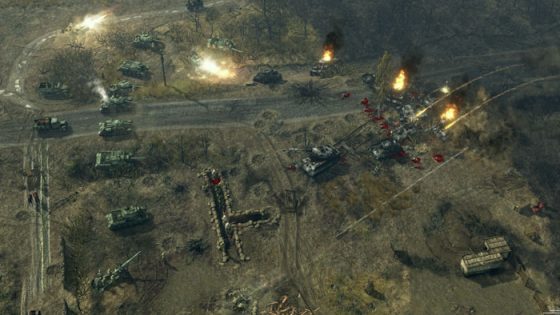
Sudden Strike 4 is to be the fourth game in the Sudden Strike series: RTS strategy games previously only available on PC. Set during World War II, the Sudden Strike games places you in command of various military forces, including the Allies, Germans, and Soviets, with your objective being to complete campaigns based on real world events. With it being almost ten years since the release of Sudden Strike 3, this fourth installment offers up some pretty significant graphic improvements, alongside various gameplay changes which we'll be taking a look at during this review.
While Sudden Strike 2 went down very well with existing fans, the third game received a less positive response, so this fourth installment should hopefully provide those fans, who are still looking for a sequel to the game they loved, with what they were always hoping for. As for those of you who have never touched the Sudden Strike series, if you're interested in strategy games and up for a challenge then this could be the new release for you, though be warned, there's a steep learning curve for those less learned in the ways of the RTS genre.
What to Expect
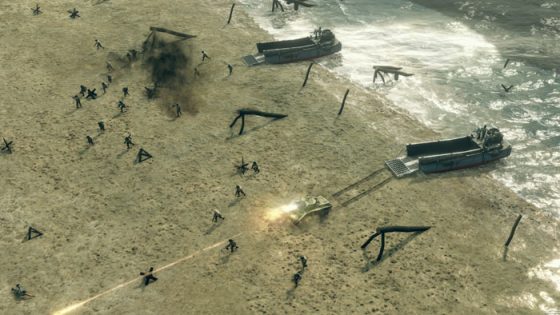
From our hands-on review, Sudden Strike 4 offers both a single-player campaign, as well as online and local multiplayer options, so regardless of whether you're a solo player or a PvP beast you should be set. The single player campaigns offer up 21 missions currently, with several difficulties, as well as special challenges and mission requirements to add something extra if that's what you're after. There's also a Skirmish mode if you want to take on the computer in a battle to the death rather than a scripted mission. The multiplayer is a similar set-up but instead, you're pitted against other human foes in a strategic fight for survival.
An interesting difference between Sudden Strike 4 and previous games in the series will be it's availability on console, with a PS4 version planned for release a few days after the PC version. Although we've not been able to take a look at the console release ourselves, with strategy games rarely finding much success on consoles, it's going to be interesting to see how the developers at Kite Games have handled it. Fittingly the online multiplayer will also be cross-platform, which may be a blessing or a curse depending on how you see it. Either way controller support is offered for the PC version as well, and we can only assume they made the console decision knowing well what they were doing.
[ad_top2 class="mt40 mb40"]
Gameplay Review
Content
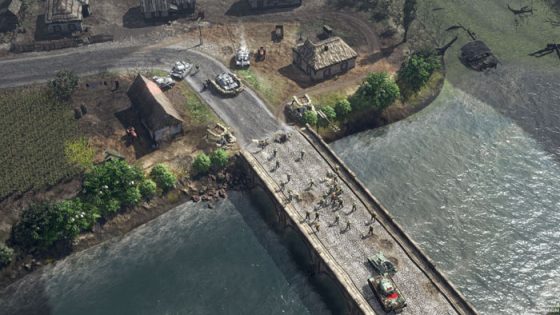
With online multiplayer available, as long as the community is there, Sudden Strike 4 offers up hours upon hours of replayability for those who enjoy crushing lesser commanders. With up to eight players in one game, you can expect some pretty huge armies and seriously chaotic battles ahead, as well as of course one vs one option if you'd prefer a slower and more strategic head-to-head encounter. Kite Games are also allowing some degree of modding, which is a big reason why predecessor Sudden Strike 2 has had such a long lifespan, so there should hopefully be plenty of user generated content to come in the next few months.
As for the single player campaign, each mission has a one to three-star ranks that are earned based on your performance, so if you're a completionist you could easily spend a long time just trying to three-star them all. Each of the missions also has an extra challenge that unlocks only after you complete them with three stars, adding yet another level of difficulty. Overall if you like being presented with difficult single player content, Sudden Strike 4 has got you covered. You can also, of course, enter a skirmish game and put yourself against up to four opponents if you just really hate yourself.
A new feature to the series, Sudden Strike 4 introduces Doctrines, offering players three "talent tree" like paths to choose from and utilise on the battlefield. Each side (Germans, Soviets, and Allies) has a choice of three Commanders who specialise in different areas: Support, Armored, and Infantry, each providing specific units with benefits such as new abilities or armor bonuses. This adds a little more spice to the campaign mode, as stars you earn on missions are required to unlock new "talents", and also perhaps adds more tactical options to multiplayer games.
The content certainly exists to appease those who are already into strategy or RTS games, but what about newcomers? Well, we'd say that the tutorials and assistance offered to anyone unfamiliar with the game are somewhat lacking. After the first tutorial mission you're pretty much left on your own with a bunch of units that you've never seen before, and have to kind of work things out for yourself. So if you're new to the game, or more importantly the genre, you might find yourself looking up some tutorial videos before long, as otherwise, it's going to take a while to get used to the fairly niche gameplay of Sudden Strike 4 from our hands-on experience.
Mechanics and Controls
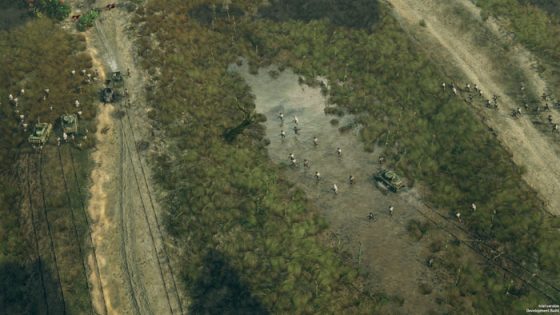
We'll start off by mentioning the controls: Generally speaking, these were exactly what anyone would expect from an RTS. Everything has a hotkey, and we particularly liked how obviously the control groups are displayed at the top of the screen, with unit icons to remind of generally which control group is which. Putting your units into formations is the one thing that could use a bit of work, as when you right click and drag to decide their formation, there seems to just be a choice between "organised" and "all over the place".
Battles are intense, and with each unit being worth its weight in gold, you really need to take it slow if you plan on winning (and getting those stars!) You can pause, and queue up commands so as to stay on top of things, and with the gameplay being rather fast you're going to want to keep doing that to stop yourself losing random riflemen. Although the tactical pause mechanic works just fine we can see how a 25% or 50% speed option could make the game a bit friendlier, given how easy it is to make terrible, terrible mistakes.
Graphics and Sound
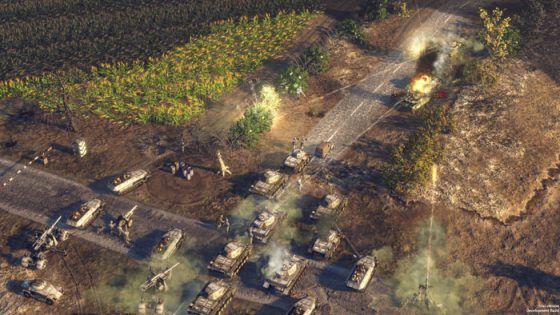
If there's one thing that sets Sudden Strike 4 apart from its predecessors more than anything, it's the graphics. The terrain looks simply fantastic, whether it's the green farmland of France or the harsh wintery tundras of Russia, the attention to detail is on point and will continue to impress throughout the campaign. The same goes for the units themselves, with the infantry looking good and remaining easily distinguishable from each other, and the detail and animation on the tanks making them pleasing to watch crashing around the battlefield. The animation for the explosives and generally speaking the weaponry was nothing to write home about, but this perhaps is better in keeping with the realism that Sudden Strike 4 is aiming for.
The sound is a little more average by comparison, with the main thing worth mentioning being the voice acting. Before going on it's worth pointing out that the game is fully voiced, which although often expected these days, is something we appreciate nonetheless. The units themselves have decent voices, with them (to my British ears at least) sounding believable in German or Russian, for example. On the other hand, the voice-overs during the campaign sounded a tad awkward, with the apparently Russian commander sounding a bit like he's from the US, and the German voices having a mix of US and British origins, with the occasional "Kommandant" thrown in. We couldn't help but feel that we were always fighting for the allies, even in the midst of a Russian winter.
[ad_middle class="mt40 mb40"]
Honey's Gameplay Consensus:
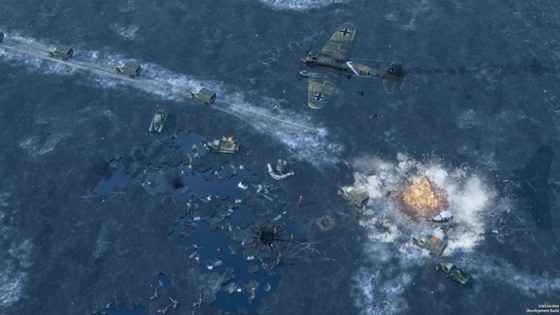
So overall, what did we like about our review of Sudden Strike 4? Well, the challenge of the campaign certainly gave us something to chew on for a while, though it may be something that genre veterans overcome with significantly more ease. It's clearly a complex game with the potential for you to handle campaign missions in numerous different ways, and for multiplayer matches to get very interesting when different tactics come into play. The graphics are just fantastic, and some of the attention to detail was much appreciated, such as when tanks roll over icy lakes and you can see the surface cracking behind them. We also just enjoyed blowing infantry up with tanks, to be honest.
One of those positives can be put the negative list as well though, by which we mean the complexity of the game. Personally, it reminded me a bit of when I started playing DotA2 and there was simply an overwhelming number of things to learn before you even felt semi-competent, which could a big barrier if you can't quite get into the game in the first place. We should also mention again how the gameplay just feels a little too fast for what is supposed to be a slower-paced, more strategic game. We get the vibe that the developers were only ninety percent sure what kind of game they were making, as well as who their target audience was.
Honey's Pros:
- Very pretty graphics, particularly for the terrain.
- Solid campaign with lots of extra challenges.
- Plenty of replayability with online multiplayer and modding potential.
Honey's Cons:
- Steep learning curve for newcomers to the series.
- Gameplay is perhaps too fast for a slow-paced, strategy game.
- Lack of tips and tutorials makes an already complex game seem even more complicated.
Honey's Final Verdict:
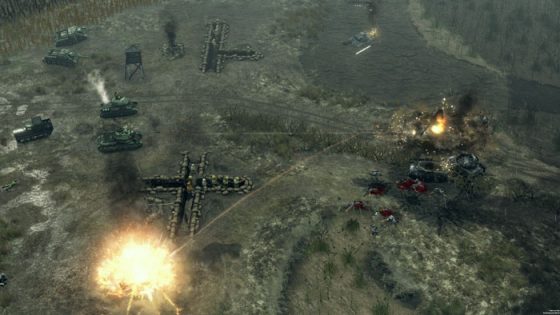
Sudden Strike 4 seems to have been made with fans of the previous games in mind, with added flair to attract new players. So if you're someone who played the previous installments and doesn't mind some of the gameplay changes that have been introduced, you might be able to find a new friend in Sudden Strike 4. If you're new to the series, prepare for a world of hurt as you get used to the gameplay, but if you do manage to reach the top of the mountain you may find it quite rewarding.
So, we hoped you enjoyed our review of Sudden Strike 4, and we would love to hear what you think about the series as well as this new addition on the rise! Whether you're a Sudden Strike veteran or you're just interested in picking up this latest release, be sure to leave us a comment down below.
[author author_id="031" author="" translator_id=""]
[ad_bottom class="mt40"]
↧
Citadel: Forged with Fire - PC Review

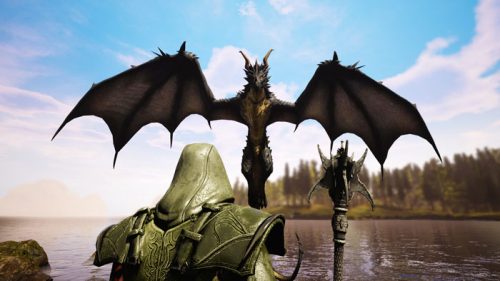
But Can We Actually Build A Citadel, Tho?
Game Info:
- System: PC, PS4, Xbox One
- Publisher: Blue Isle Studios
- Developer: Blue Isle Studios, Virtual Basement LLC
- Release Date: 26th July 2017 [Steam]
- Price:$24.99 [Steam]
- Rating: Rating Pending
- Genre: RPG, Open World, Adventure
- Players: Single-player, Multi-player
- Official Website: http://www.citadelgame.com/
Who it Caters to
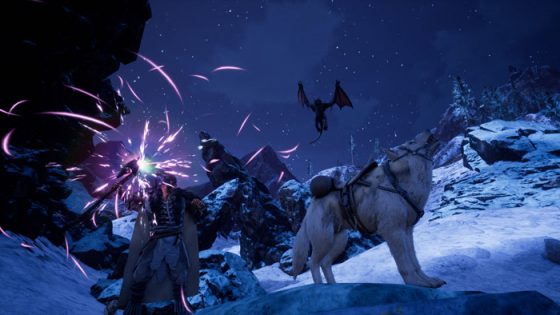
Citadel: Forged with Fire is very much following in the footsteps of games like Skyrim and Ark, turning away from standard RPG gameplay in favour of an open-world, sandbox approach. The concept is to effectively let you do whatever you want within the game's expansive world: from PvE leveling and exploring, to taking on powerful monsters as part of a team or warring with other players over your lovingly crafted towns and citadels. So in a way, Citadel is potentially a game for anyone, whether you want to go solo or prefer playing with friends, if you like fighting monsters or other players, you can find your own way to play.
Although, as we just mentioned, solo play is very much part of the game, we would provide a disclaimer though that as of now, the devs seem to be focused mostly on improving the multiplayer experience, as well as tailoring the game's challenges to groups of players rather than single-players. Also that as the game is in early alpha, the amount of content currently available may be better experienced with a group of friends, particularly as many of the stronger enemies require quite a bit of grinding to take on if you're all by your lonesome.
What to Expect
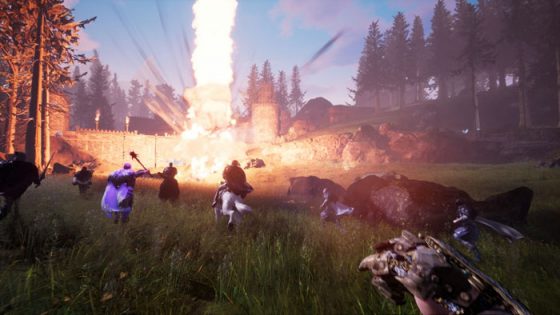
Currently, Citadel: Forged with Fire is being sold as an early access title and seems to be very much in the alpha phase of testing, with a significant chunk of missing content and some interesting bugs to be found. So as with any early access title, it's best to approach Citadel with an open mind and remember that it isn't supposed to be finished quite yet. With that said, much of the base game is workable, including the huge, and quite beautiful, environment, the crafting and building system, and the combat mechanics. Some of the most frequent changes the devs are currently making are to the game's balance, as damage and spells still need some fine tuning.
In terms of what to expect, we'd say you can look forward to a whole lot of exploring, as well as being able to challenge yourself by taking on some of the games harder enemies residing in the far corners of the world. The building system is also pretty solid already, so if you like making something of your own then you could easily spend hours crafting your own house, fortress, or castle if you're willing to collect enough stone! If you're really into player vs player combat then the thing to look forward to most is probably being able to take part in House wars between groups of players, as well as raiding your enemy's fortresses for both loot and your own satisfaction.
[ad_top2 class="mt40 mb40"]
Gameplay

Content
What we found most impressive about Citadel: Forged with Fire so far was the sheer size of the map, as well as the level of detail that's been put into its creation. The world spans 36 square kilometers and covers environments from tranquil woodland areas to snowy mountains, and lands that look infected by some kind of plague. Spread across the lands are a variety of odd points of interest such as acid pools which you can lure enemies into, as well as monuments that grant you buffs, and towers that allow quick travel. Enemy camps and caves are spread about the map as well, providing some interesting places to explore, as well as chests packed with loot. Hopefully, the caves and dungeons get some more love in the future as some of them are a little small as of now.
As we mentioned before, building is one of the most advanced parts of the game currently, with many players setting up private servers so that they can remake real buildings in-game, or live out their wildest fortress building dreams. We only made a simple house so that we could give ourselves a place to respawn and craft our wears, but if you have grander plans, then Citadel will surely accommodate you. Of course, it's important to remember that on PvP servers your creations can be raided and destroyed by other players, so you'll want to set up some turrets to defend it, and just generally just keep an eye on it.
A note on servers, Citadel has "Official" servers that house a large number of players and go by the regular game rules, but also allows you to create private servers. The number of players allowed on each server, as well as the rules it follows, is decided by the admins. For example, you can change between PvP and PvE types, increase experience gain, or turn off inventory weight limits just to name a few of the options. We cranked up experience gain a bit on our server because we couldn't quite wait to take on some dragons.
With regards to the multiplayer aspects of the game, currently, it's possible to make Houses, similar to your standard MMO "guild" concept, and attack other player's bases with your friends. The developers are hoping to add more formalities in the future, allowing you to declare war on other houses, as well as engage in duels and other types of competitions. Besides PvP, taking on dragons and the like with other people is awesome and presents a nice challenge at lower levels. The developers are planning to implement world bosses and other interesting enemies before the game leaves early access as well, so there's still more to look forward to.
Gameplay and Mechanics
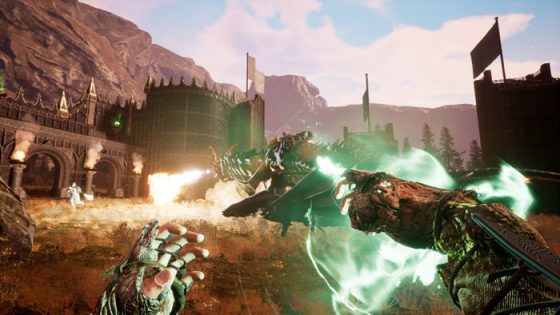
Despite the strong PvP focus, combat is possibly the mechanic in Citadel that could use the most refining or improvement. The default camera view for the game is first-person, though you can swap to third-person, and you aim your spells and weapon attacks using a crosshair in the middle of the screen. As of now although there are a reasonable number of weapons and spells available, adding to that library would be a big improvement in terms of player customisation. We were also surprised to find that there are currently no ranged weapons in-game, although they are planned. All that said, we didn't actually encounter any problems with the combat and everything flows fluidly, so we can see why it might not be a priority for improvements over other areas.
The leveling and character customisation is another area which works just fine but leaves a little to be desired. Leveling at regular experience rates is pretty slow and can get quite grindy, but thankfully the higher experience rate servers solve that issue. As you level you gain points to increase your health, mana, damage, and weight capacity, as well as Knowledge points which give you access to new spells, recipes, or other proficiencies. We really liked the Knowledge system to be honest, as it's simple enough that you don't have to spend a hideous amount of time planning your points, but complex enough to allow us to make the character that we wanted to play. You often find yourself making a trade-off between improving your spells and damage, or your crafting, and we imagine as more content gets added to the game, these tradeoffs may present some difficult decisions as you close in on the level cap.
Overall the gameplay itself in Citadel is actually pretty simple, with the complexity of the game being more about what choices you make when designing your character, building structures, or organising a team. As we mentioned before, the developers are constantly tweaking spells and enemies with regards to the game's balance, which is nice to see, and although we certainly found plenty of challenging content, even in the lower level areas, nothing felt needlessly frustrating or janky.
Graphics and Sound
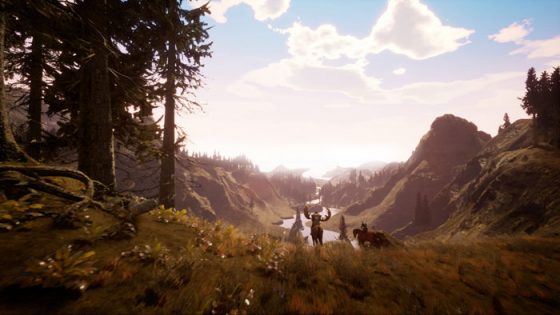
Citadel: Forged with Fire is certainly a nice way of testing the limits of your PC. The amount of detail put into the foliage and textures is amazing and makes us glad we invested in that GTX 1080. No matter where we were we found ourselves wanting to just take random screenshots: it's like being surrounded by photo opportunities everywhere you look. The lighting at sunrise and sunset is particularly gorgeous and makes even some of the grimmer environments look just wonderful. Speaking a little on in-game models, we thought the dragons were all really well done: from their appearance itself to the detail put into their walking and flying animations.
Currently, the game does not contain any voiced lines, none that we found at least, and many of the sound effects are what you would expect from any fantasy RPG. A fireball sounds like a fireball. What we did like was the ambient sound that's used to add to the immersion of the game, such as the sounds of birds and critters when you're in a forest which is noticeable but pleasantly subtle.
[ad_middle class="mt40 mb40"]
Honey's Gameplay Consensus:
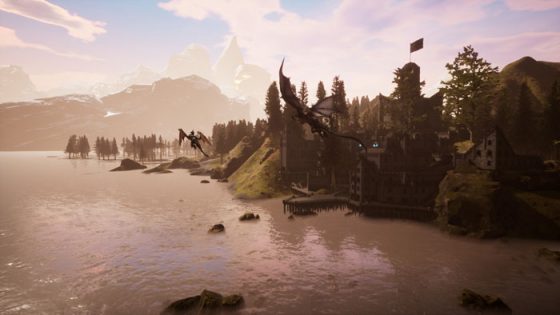
Despite being an early access title, we've had trouble pulling ourselves away from Citadel: Forged with Fire. While fairly grindy, the leveling system is rewarding and advancing through the Knowledge tree really does provide your character with a lot more options. Although the world may be sparse in terms of events and points of interest, it retains enough mystery and beauty to be worth exploring, as well as providing constant challenges as you progress through the more difficult areas. Our playtime was mostly limited to single-player style gameplay in what is really a multiplayer focused game, but we never felt we were missing out on a lot, as even the single-player experience was rewarding enough to keep us busy.
On the flip side, the game still has a long way to go before it becomes a full release title, with a fairly long list of features waiting to be implemented. The lack of friendly NPCs of any kind, for example, feels a little odd in what is an otherwise flourishing environment and leaves you feeling a little lonely. Numerous features simply need building on, such as the Houses system, and there is currently a notable lack of variety in items and enemies. We're also aching to get our hands on some kind of ranged weapon.
Honey's Pros:
- Map is big and beautiful
- Building mode
- Great multiplayer potential for PvE and PvP
Honey's Cons:
- Still lacking content
- Unusual bugs
- Lack of NPCs or quests detracts from the single player experience
Honey's Final Verdict:
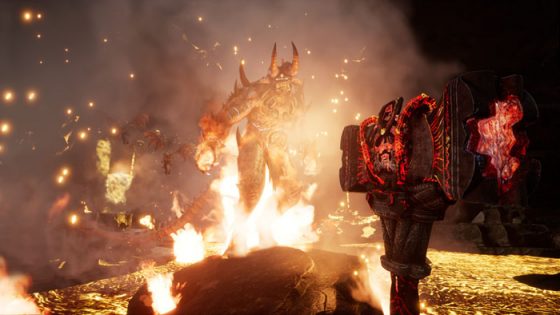
Overall, Citadel is solid for an early access title and has some huge potential. Just be sure to measure your expectations before you go in and you won't be disappointed. One thing's for sure, Citadel: Forged with Fire has a lot to compete with, with games like Light and Dark, and Ark also offering a sandbox style fantasy experience, and even Skyrim still going strong for those who favour single player adventures. Hopefully, Citadel gets the updates it needs fast enough to stay relevant.
Had the chance to try out Citadel yet? What did you think? Or if you haven't played, what are you hoping for from the title? Be sure to leave us a comment down below and let us know your thoughts!
[author author_id="031" author="" translator_id=""]
[ad_bottom class="mt40"]
↧
↧
6 Waifu Like Sagiri from Eromanga Sensei [Recommendations]
With the Spring season now long gone, seasonal waifu Sagiri must now fend off the Summer newcomers to maintain her position in the hearts of viewers. We're partly kidding of course, but Waifu Wars are pretty serious business on the internet. Whether you loved her or made room for her in your bin though, it's […]
↧
Moero Chronicle - PC Review

Moero Chronicle Successfully Delivers On Its Promise Of Moe
Game Info:
- System: PC
- Publisher: Idea Factory International
- Developer: Idea Factory, Compile Heart
- Release Date: 16th August 2017
- Price:$19.99
- Rating: Rating Pending
- Genre: RPG, Dungeon Crawler
- Players: Single Player
- Official Website: http://ideafintl.com/games/4808.html
Who it Caters to

Yet another of Idea Factory's PlayStation Vita releases making its way to PC recently, Moero Chronicle couples the recent popularity of monster girls with an onslaught of fan service to produce a fairly niche, but powerful title. The main catch of the original was the use of the PlayStation Vita's touch screen to shamelessly rub innocent monster girls up and down, an important feature which remains with this PC release. With even the monsters, clad in panties and little else, unable to escape from the grimey grasp of fan service, Moero Chronicle is only for those who prioritise cute girls over all else.
Additionally, somehow the gods of ecchi and all things ero have shone their light upon this title, and it has managed to avoid the censorship police entirely, although there was never any full blown nudity even in the original Japanese release. Still, it's rare to see such an openly ecchi title make it to the west untouched, and as much as the game is about cute monster girls, the focus is mainly on just how little clothing you can put them in. So as we said before, you've really gotta be in it for the girls to appreciate this title.
What to Expect

As a dungeon crawler, Moero Chronicle isn't overly focused on a storyline and wastes no time getting into the action from the start. After a short introduction, you're thrown into the Mushroom Forest where you quickly pick up how to navigate the maze of shrooms, how to battle, and perhaps most importantly, how to entice monster girls to join your party. While the main story is fairly light hearted though, there is an overwhelming number of opportunities to chat with your new furry, slimy, and scaly companions, so that you can get to know them a little better before putting them in the chain bikini. Actually, you can do that pretty much right off the bat, but there are other benefits to gain from bringing the girls gifts, engaging in their events, and even upgrading their rooms at the Inn. They're like the sexy monster girl version of a Tamagotchi.
While the visual novel elements make up about half of the game, the other half is taken up by fighting and exploring the monster side of the world. The fighting itself is nothing mind-blowing, though battling the higher level monster girls poses somewhat of a challenge, as does the rubbing mini-game to make them yours. The exploration as well is pretty standard as dungeon crawlers go, and while not quite as complex as similar games like Etrian Odyssey, provides enough mystery to keep you moving forward. Overall, we'd say the main thing to expect from Moero Chronicle is amusing conversations with cute monster girls, who are perhaps not wearing very much.
[ad_top2 class="mt40 mb40"]
Story

You are a perverted teenager. Sorry, we mean you play as a perverted teenager, named Io, who has recently realised that all the cute, sexy monster girls surrounding him are indeed, cute, sexy monster girls. A revelation we're sure. Although the world is separated into the "Human" side and Monstopia, where the monsters live, everything was fairly harmonious until recently. After the appearance of a legendary monster girl in the heart of Monstopia however, all the other monster girls started acting a little, odd. All of them, except for the girls in Io's town. Now it's said town's turn to send a hero to try and defeat the legendary monster girl, and as Io's never done anything useful before, he's been selected as their sacrifi- hero, to venture into the mushroomy depths of monster girl territory, and hopefully return victorious.
Alongside our cookie-cutter, pervert otaku protagonist is his very pretty childhood friend Lilia, who appears to be some kind of wolf girl, their kitty cat friend Leche, and an ever expanding host of other monster girl treats, including slimes, bees, imps, dragons, and a whole lot more. You also acquire the world's most perverted otter, Otton, along the way, who's masculine voice does not match his comical appearance or personality in the slightest. Alongside the main story, the girls also get their own events and stories as you increase your intimacy with them and progress through the game, adding another more moe dimension to the plot.
Gameplay
The Girls

Let's start off with what we're really here for: the girls, which is evidently where most of the game's budget went. With up to 50 collectable girls, all voiced, with their own trope-y personalities, extra costumes, and individual events, Moero Chronicle is debatably a better galge than it is a dungeon crawler or RPG. We had no trouble burning time at the inn, where our new monster pals had settled in nicely. Depending on how much you like auto-ing through dialogue you may or may not be a fan of the inn to be fair. But we at least believe there's joy to be found in listening to the happy squeaks Lilia makes after we gave her a bag of sand and someone else's panties. If only that worked in real life. While the bag of sand increased our intimacy with her, the panties unlocked a new outfit which happened to be the smallest swimsuit in the world. We could also upgrade her room to boost our intimacy further or spend some "rub points" we earned down in the dungeon to pinch and poke her to climax. There's also a strange synthesis mechanic involving merging panties with defeated enemies to make eggs containing items, but frankly the details of how on earth that works are at best, alarming.
When you're spending time with the girls down in the dungeon things are a lot less cosy, but we still found a large number of events where we could chat with our furry friends despite the dangerous surroundings. Lilia seems to get the most events as she's the main girl, but a good number of the other monsters take part in the main quest at some point. Of course, you'll also encounter a couple of new girls on each floor who you'll need to rub into submission. When fighting a wild monster girl your first job is to destroy all their clothing, after which the"Bumping Scratch" mini game begins, which, just like back at the inn, requires you to caress all of the girl's most sensitive spots in order to free her from being brainwashed. This is a bit tricky to do with a controller, to be honest, but we just about managed.
The Dungeon

That about explains your interactions with the girls, but what about the actual fighting and the dungeon crawling? In the battles themselves, our heroic protagonist actually doesn't do any fighting at all, taking a backseat while his harem fights tooth and claw. Io has a few options to choose from each turn, including using items or running away, but his special talent is charging up his Desire. Desire can be charged up to a max of 100% and is used to power up your girls' attacks. Honestly, we mostly found ourselves having Io use healing items, or even just idling in random encounters, partly because his "charge up" sound is... questionable. As for your girls, they each seem to have their only specialty, although no class system exists in the game.
For example, our slime seems to be a kind of knight because she has high defense, and our dog girl is a mage with fire and healing spells. They also get traits like "Animal Ears" and "Loli", which grant bonuses like increasing the attack of every other girl with animal ears in the party. Overall, with so many different girls and a variety of different traits and classes available, you can arrange your ideal party quite easily. Girls who are left back at the inn also gain experience while they're there, which is a feature we really liked and certainly saves on the hassle of leveling everyone up together.
The dungeon has some basic features that add a bit of flavour to making your way through the floors. There are numerous chests you'll find scattered about, often holding either new equipment or fresh panties to unlock new outfits for the girls. There are also doors with switches, damaging floor tiles, and "strong enemy" encounters you'll meet on the way down. Though not riveting by any means, the dungeon exploring was entertaining enough to keep us going between events, though as you're able to Auto through most of the random encounters without difficulty, the lack of challenge can make it fairly repetitive.
The Rest

That's about it as far as content and gameplay goes, and all in all Moero Chronicle is, like many dungeon crawlers, a fairly simple game fundamentally. Though in this case most of the joy comes from the cute girls rather than the challenge.
Concerning the sound design, the music is quite frankly forgettable at best, but we could really appreciate the voice acting. The VAs did a good job making each girl feel unique, whether it was their manner of speaking or their unusual accent. One of our favourites was the tomboy Troll. This, of course, goes for the ecchi scenes as well, which we could really "appreciate". On a slightly related note, one thing we did find amusing was the number of typos throughout the English translation, which was surprising given that this is effectively a re-release. You'd think they'd have checked the script just one more time just in case.
The last thing we'll mention before finishing up in the game's art which we really liked, but isn't without fault. Most of the girls are drawn such that they represent their monster pretty accurately, though we're a little sad that the slime girl isn't actually a slime girl, and the effort put into their extra outfits is very much the icing on the cake. Something that struck us as off was that the girls only have one artwork each, meaning that even when having a casual conversation with our troll companion, she remains bent over with her butt in our face. While not necessarily a bad thing by any means, it would've been nice to see some more variety for each girl.
[ad_middle class="mt40 mb40"]
Honey's Gameplay Consensus:

Moero Chronicle is a game that's trying to cater to a very specific audience, and we think it does so quite successfully. But if you're not in that ecchi-loving, moe-monster-girl-crazed fan club, then it might not be quite to your tastes. While we didn't find the dungeon crawling itself wildly exciting, the sheer volume of monster girls in Moero Chronicle did leave us somewhat in awe. The time we spent chatting with them and poking them was good fun, and although lacking in variety, the pretty art work satisfied our moe quota for at least a week. With a reasonable amount of content, we think that Moero Chronicle justifies its price tag, just be aware of what you're walking into beforehand!
Honey's Pros:
- Delivers on moe goodness
- Huge character variety
- Lots of amusing, cute dialogue
Honey's Cons:
- Dungeons and battles can get repetitive
- Lack of challenge
- Could use more variety in character artwork
Honey's Final Verdict:

Though it still feels like a portable title in many ways, we did enjoy this PC release of Moero Chronicle, and hopefully, this paves the way for its sequel Moero Crystal to make an appearance in our game library soon. Along with the recent release of Superdimension Neptune Vs Sega Hard Girls, Moero Chronicle is another title in Compile Heart's recent flood of PlayStation to PC ports, a theme that we, in general, hope will continue with even their latest releases. On that note, we think it should be said as well that if you are a fan of Compile Heart's other titles, that Moero Chronicle might be worth at least taking a look at.
Had the chance to try out Moero Chronicle yet yourself? Looking forward to picking it up soon? Let us know what you think about this latest PC port in the comments below!
[author author_id="031" author="" translator_id=""]
[ad_bottom class="mt40"]
↧
6 Games Like DotA 2 [Recommendations]
Now, one of the most popular games in the MOBA genre, Defense of the Ancients has come a long way since its humble beginnings. Starting off as a mod for Warcraft 3 named DotA All-stars, the long awaited sequel-slash-reboot DotA 2 went into beta in 2011 and was finally released two years later in July […]
↧
[Slice of Life Summer 2017] Like Kobayashi-san Chi no Maid Dragon? Watch This!
This one goes out to all of you slice-of-life lovers looking for something relaxing to watch on a warm summer evening. Is it still summer? Kind of. Anyway, today we'll be looking at a couple of Summer 2017's cute girls doing cute things series, that we think you'll be interested in if you were a […]
↧
↧
Superdimension Neptune VS Sega Hard Girls - PC Review


How Much Nep Would A Nep-Nep Nep if a Nep-Nep Could Nep Neps?
Game Info:
- System: PC
- Publisher: Idea Factory International
- Developer: Idea Factory, Compile Heart, Felistella
- Release Date: 12th June 2017 [Steam]
- Price:$29.99 [Steam]
- Rating: T for Teen
- Genre: JRPG, Action
- Players: Single Player
- Official Website: http://ideafintl.com/nep-sega-us/
Who it Caters to

Superdimension Neptune VS Sega Hard Girls was originally released in 2015 for PS Vita, with the English release coming later in 2016. As a spin-off of the Hyperdimension Neptunia series, players of the original can expect similar gameplay and the return of some much-loved characters, along with the new addition of the girls from the Sega Hard Girls franchise. While the original release didn't get a lot of attention due to it being limited to the, not so popular in the west, PS Vita, this release seems to be aiming to relaunch the title to a broader audience, with some graphic upgrades thrown in.
As a spin-off, Superdimension Neptune VS Sega Hard Girls has no relevance to the original series' canon, so while long time fans will be able to enjoy the return of Neptune, Nepgear, Plutia, Uzume, and Histoire, along with numerous 4th wall breaking references and meta in-jokes, newcomers won't be missing out on too much in terms of story background or character history, making this a decent entry to pop your head in on and see what the all the Neping fuss is about.
What to Expect

Superdimension Neptune VS Sega Hard Girls kind of feels like a very elaborate visual novel rather than a serious RPG. About half of the playtime is spent in dialogue sections listening to the girls talking about super serious things, supernormal things, and super dumb things, a fairly nice mix. As with all Neptunia games, comedy is a big focus, and as you start meeting more of the girls the arguments and general idiocy become pretty amusing to listen to, as well as them all being very cute of course. There are choices you can make during one or two of these sections which give you alternate dialogues, but they don't seem to affect the story too much and so are mostly just little touches to satisfy the player's personal preferences.
The other half of the game is button mashing, turn-based combat, which is fairly simple but has a few nice little mechanics to add some spice. The gameplay itself is certainly not challenging but does allow for a decent amount of customisation with 10 characters to choose from, each with more than one playstyle, as well as numerous different outfits to dress them up in, which is very important. The overall experience is somewhat akin to being in a rowboat on a river: sometimes you need to work those oars but generally speaking the flow just takes you where you want to go, and frankly, you're mainly there to relax and watch the pretty scenery anyway. And sometimes play dress-up with cute girls.
[ad_top2 class="mt40 mb40"]
Story

The protagonist of Superdimension Neptune VS Sega Hard Girls is a completely new addition to the series: IF. IF is an adventurer who rides about the wasteland of a world she inhabits on her beloved motorbike, always searching for a new adventure. Finally finding the legendary grand library that she's been searching for recently, she spots a girl falling from the sky and catches her. IF decides to take the unconscious girl with her into the library, where despite the place remaining untouched for years, there is fresh trouble afoot. Various cliches occur, and the two girls must band together to stop history being devoured by a crazy snake monster thing known as the Time Eater. We skipped a couple of steps but you get the idea.
During the game IF and her new partner Segami must visit four different eras, with the help of IF's newly modified time traveling motorbike, and make sure that the history of each era remains safe. The eras are all based on old Sega consoles (Game Gear, Saturn, Dreamcast, and Megadrive) and the history related problems seem to centre on an old rivalry between the Neptunia Goddesses and the Sega Hard Girls that's getting a little bit out of hand. The more of time that you repair, the more prepared you are to face the Time Eater and save history!
Gameplay
Content

As a spin-off game originally made for a portable console, despite being a JRPG Superdimension Neptune VS Sega Hard Girls sits at a fairly comfortable 20 hours of gameplay for the main story, taking around 25 to 35 hours for 100% completion. Were this a title in the main series that might give one reason enough to ask questions regarding the amount of content, but honestly the length feels just right, with there being enough time for the game to tell its story, show us some cute characters, and tie everything up before the mechanics start to get repetitive.
The main quest line contains a large number of events that push the story along fairly quickly whilst also including some amusing banter. There's not much extra development regarding the plot within the side-quests, so they exist largely to get you to a high enough level so that the main quest bosses don't smear your adorable, squishy body across the floor. Although not part of the story, there are lots of extra characters that pop up, including a load of chibi Sega Hard Girls, who have some funny little dialogues and make the game feel more much populated.
To speak of the world today's 2D waifu inhabit: there's the main hub, the grand library, which has shops, quests, and basically everything you'd expect the main hub to have, and then there are four different versions of "the world" which you can port to. Each version, as mentioned before, is set in a different time period, and thus in some of them certain areas become available, unavailable, or change their layout somewhat. For example, the forest area has a different layout in each of the first three time periods and then gets a reskin to look much grimmer in the final time period. We're of two minds about this, as although it means a large part of the game involves rerunning what are essentially the same dungeons, there are enough differences that part of the fun becomes seeing the changes between each one. One final thing to note is that they've added some new mechanics to dungeons, such as crawling and climbing, which make them more interesting to traverse than in previous games.
Gameplay and Mechanics

With RPGs, the plot is of course generally the top priority, but perhaps the second most important thing is the battle mechanics because battles are exactly where you're likely to be when you aren't listening to Neptune talk about how popular she is. Superdimension Neptune VS Sega Hard Girls turn based combat is pretty quick and a little repetitive, but it suits the tone of the game nicely. When you're running around dungeons you can hit enemies with your weapon to start a "Symbol Attack" encounter, giving you an extra turn, or alternatively, your foes may rush you and get the first strike themselves.
When in battle you get an "Action Bar" that fills up with each action you make, such as moving around, attacking, or using items, and once it's in the red your turn is over. You can use fewer actions to strategically get your next turn sooner, or overload the bar for a stronger charge attack as well. As you deal damage you build up SP which is used for special attacks, some of which are pretty strong, such that the SP bar feels like a nice way to balance them. "Gems" sometimes show up on the battlefield which you can collect for extra health or SP, which isn't really necessary for most fights but adds a little reward for paying more attention during battles. The last main point to mention is "Fever Time" which you can activate once your "Fever" gauge builds up to full and essentially makes it continuously your turn for a large number of actions, as well as give you access to "Overdrive" attacks, which are super over-the-top and feel awesomely chuunibyou.
We would've loved to see perhaps some kind of combo system for regular attacks, similar to the main Neptunia games, as most random encounters are ended by just smashing the X button. Overall though the combat is just fine, and activating all your Overdrives during boss fights just feels so good. They've also hit a nice balance between giving the girls cute lines and animations during encounters, but also making them really cool with crazy attacks and very "anime" chants, which we think are both very important parts of JPRGs.
One thing that surprised us was how fast the leveling is in the game, though this makes sense given that it's shorter than your average JPRG. Because of this, you're constantly being rewarded with new skills and passive abilities which are always cool to test out in battles, and it's easy to switch out party members and play around with your new toys, particularly as even characters outside of your team get XP from battles. The girls also have multiple classes with different skills which you level up separately, but they level up so quickly that you can swap between them pretty easily as well. The whole leveling system really feels like it's designed for you to just have a bit of fun messing around with, rather than a standard JPRG grind.
Moving on from the battle mechanics, the way the quest system works is fairly interesting. Each quest is assigned a number of "days" before it gets "eaten" and removed, with a day passing each time you complete a quest. The difficulty of each time period increases as you progress through it, so if you burst through just one or two periods and ignore the others then expect some brutal boss battles and dangerous dungeon mobs. Without giving too much away, you will get the chance to redo the harder, or already eaten, quests later in the game, so achieving the true ending isn't too much work.
Art and Sound

We tried Superdimension Neptune VS Sega Hard Girls with English voices and Japanese ones, and though the English voices are just fine, we still prefer the original Japanese cast. This is, of course, going to be largely down to personal preference, but we're also not sure how we feel about all the cute girls swearing all the Neping time in the English dub, something which isn't present in the Japanese dialogue. Whilst the translators have taken quite a lot of liberties with the tone of the conversations though, the story remains fully intact from what we could see. Beyond the voice acting the music actually felt really well done, setting the tone of each different time period perfectly and being overall very varied. We'd be happy to pick up the OST sometime.
Regarding the art and graphics, as we mentioned before they've gotten a bit of an upgrade from the PS Vita version, with the bright cel-shaded visuals looking really smooth and fitting the anime style of the series as always. The art in the visual novel style sections is lovely too, with some slight animation included making the girls look a bit more lively. The expressions during these parts are absolute gold and complement the equally amusing dialogue. Superdimension Neptune VS Sega Hard Girls isn't exactly going to blow you away with its visuals, but it gives you exactly what you expect and feels nicely polished.
[ad_middle class="mt40 mb40"]
Honey's Gameplay Consensus:

When we went into Superdimension Neptune VS Sega Hard Girls we already had some preconceived expectations, given the number of titles already released in the main series, and we're happy to say that our expectations were thoroughly met! The game works perfectly as a supplement for long time lovers of the series who want something fresh or just another title to play, but also acts as a great taster for newcomers who are interested to find out what kind of games the Neptunia series is, without having to climb over any existing plot progression related hurdles. The thing that stood out for us most was how smoothly the story flows despite focusing on several different timelines at once, and how neatly everything comes together in what is, for a JRPG, a relatively short amount of time.
The main downsides to the game would really be if you're not interested in cute girls being silly, or if you're after more complex fight mechanics. In the first case, well that's just what the whole series is about, and if you're not interested in the characters or comedic tone then the game just isn't for you. Regarding the combat, we'd say a little more could've been done to make it less repetitive, but there are no actual problems with it so we'll refrain from being overly critical. The final issue we had was some of the translations, which just seem exaggerated or over aggressive. The girls aren't effing and blinding their way through the Japanese dialogue, so we're not sure why they suddenly turn into balls of rage and hate in English sometimes.
Honey's Pros:
- Awesome and cute characters
- Funny dialogue filled with references
- Short and sweet
- Quirky and enjoyable soundtrack
Honey's Cons:
- Some odd translations and typos
- Fight mechanics and dungeons can get repetitive
- Cute girls aren't for everyone
Honey's Final Verdict:

We hope you enjoyed this review even half as much as we enjoyed the game itself. The Neptunia series has found itself a comfortable niche with its humorous setting, game industry in-jokes, and an array of cute characters, such that if you enjoyed any previous games, it's likely you'll enjoy whatever the next installment is. While not a true Neptunia game, the Sega Hard Girls mesh really well with the characters from the Neptunia universe, and we certainly wouldn't mind seeing them again sometime.
Are you a big fan of the Neptunia series? What did you think of this latest release? Maybe you've even played the original Vita version! Be sure to let us know in the comments below.
[author author_id="031" author="" translator_id=""]
[ad_bottom class="mt40"]
[recommendedPost post_id='158532' url='' title='' img='' class='' widget_title=''] [recommendedPost post_id='93646' url='' title='' img='' class='' widget_title='']
↧